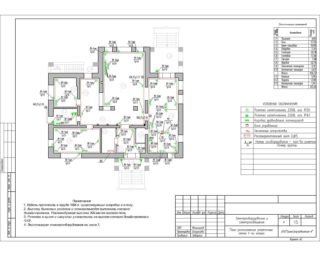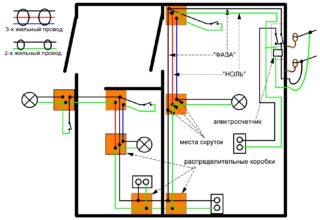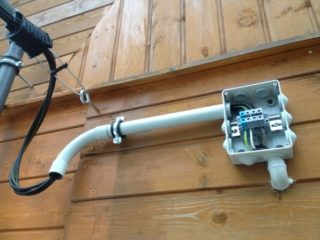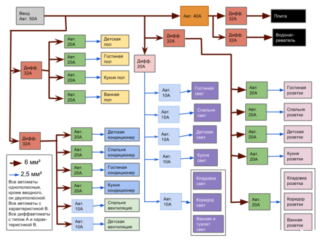Anyone who decides to build his own house, summer cottage or a simple plot for running a personal economy is forced to take up the issue of connecting to centralized power grids. This can be done during the construction of a specific residential facility, as well as after the completion of construction. To understand the essence of the upcoming procedures, it is important to understand the tasks solved during the preparation of the project and the composition of the documents included in it.
Why do you need a project

The main purpose of a typical project of an electrician in a private house is to determine the calculated data on the load characteristics of the internal network. This takes into account the individual characteristics of the erected country house or two-story cottage. According to the legislation of the Russian Federation, a project for connecting electricity to a private house is not required if the power consumption declared by its owner does not exceed 15 kW (taking into account the existing one).
When submitting an application to Energosbyt for a typical technological connection, it is sufficient to provide a calculation of the total power consumption and a single-line diagram of local power supply. However, some regional representatives of energy supply companies indicate in the contract the need for the preparation of an electrical design. In this case, it is assumed that it must provide a wiring diagram with the designation of specific consumers and accurate data on the metering device.
Typical power supply project for a private house

The power supply project for a private house includes the following mandatory documents:
- Single line wiring diagram (including distribution board).
- House plan with the designation of the locations of the equipment, as well as a diagram of the location of sockets and lighting fixtures.
- Diagram of taps outside the house, equipped for the purpose of connecting external devices or external outbuildings.
- Estimated data for the grounding loop.
- Lightning protection device organization plan.
- Specification for protective and control equipment (apparatus).
- Permits confirming the legality of the work performed by the design organization selected by the contractor.
The last sample of the working document is required if the project coordination with the power supply organization is required.
Requirements for the power supply project of a private house

Before preparing a project for a summer residence, for example, first of all, you will need to obtain technical specifications from Energosbyt for its development. They prescribe the entire list of issues related to the arrangement of electrical wiring. The following items are included without fail:
- Wiring plan for the country house.
- Type and location of the switchboard installation.
- List of equipment to be installed, including an electricity meter and circuit breakers.
- Breakdown of consumers into groups and other issues.
The TU also stipulates the power allocated to this facility (no more than 15 kW).
It is necessary to prepare an act on balance sheet, in which all attention is focused on the delimitation of the areas of responsibility of the supplying organization and the private consumer.It is drawn up in the form of an agreement concluded between two interested parties and approved after agreement.
The presence of this document allows:
- to distribute the responsibilities of each of the parties for the maintenance of "their" section of the electrical network;
- have a clear idea of who is obliged to carry out repairs in case of damage to the supply line (power cable, for example);
- connect new facilities to existing and operating power grids.
If it is not immediately possible to establish the boundary of responsibility, it is selected along the perimeter of the outer wall of a private house or the plot occupied by the owner. With mutual agreement of the parties, other variants of delimitation are allowed.
House electrical circuit

In the scheme for connecting a house to a single-phase power grid, the following mandatory points are taken into account:
- The cable or the CIP wire replacing it is connected directly to the busbars of the switchboard through an electric meter.
- After that, each power supply group must be connected through a “own” linear automatic device calculated in advance according to the current setting.
- The working zero and the protective conductor of each linear group, unlike the phase conductors, should not be switched.
The zero core "breaks" like a phase only if there is an RCD in the linear branch, which can be installed both on one group and on their combination. Further, the conductors from the group machine are laid in the direction of the junction boxes. From them, the electrical wiring is divorced to end users (power outlets and illuminators with switches).
When preparing an electrical project, the structure of the building must be taken into account, on which the chosen method of wiring depends.
In houses with a large number of rooms, when drawing up the wiring diagram, the following is taken into account:
- when designing, it is convenient to divide consumers into separate groups: one for each room and for service outbuildings;
- in the example of a project for the power supply of a private house, separate branches with an automatic machine are taken into account, designed to protect a washing machine or oven;
- when preparing design data, the requirement for an even distribution of loads among groups is observed: due to a significant number of consumers, they often load the network unevenly.
Taking into account all these recommendations, you can proceed to the practical part of the project.
Electrical network design

On the basis of the considered scheme for a private house, when preparing a working project for an electrical network, it will be necessary to calculate the required number of groups, and then distribute consumers. In addition, it is important to decide on the methods of installing the line and calculate the possible load on all devices connected to it.
Choosing a mounting method
The preparatory procedures begin with the choice of the way in which the electrical wiring is supposed to be laid. For a private house made of timber, for example, the most suitable is an external gasket, in which it stretches along the surface of the walls. If desired, it can be hidden in pre-prepared plastic cable ducts.
It is necessary to resort to hidden laying in private houses built of bricks, foam blocks and similar non-combustible materials.
Calculation of the total load
At the next stage of work, it is necessary to calculate the total load falling on all consumers connected to the network, which is very important for their subsequent breakdown into groups. To do this, you need to figure out the number of devices and the maximum power consumed by each of them. This indicator will be easiest to find out from the passport, which is attached to any of the household products.
Summing up all the indicators and obtaining the total power consumed by all connected loads, it is possible to find out the maximum current in the circuit.To calculate it, you should use the ratio derived in a practical way, according to which a power of 1 kW at a voltage of 220 Volts corresponds to a current of 4.5 Amperes.
Distribution of loads by groups

The breakdown of consumers is carried out taking into account the fact that the total power of one group of outlet lines and lighting devices should not exceed 16 Amperes. Based on this requirement, it is necessary to distribute the existing loads to individual groups.
To connect and service powerful loads like an electric oven, a group of consumers will need to install an automatic machine with a rating of 25 Amperes.
Distribution into groups is made taking into account their distribution among rooms and depends on the power of a particular load. PUE recommends separating the group lighting lines from power outlets, which is important for buildings with a large number of rooms.
Choice of wiring
Before self-laying electrical wiring in a private house, it is necessary to carefully calculate the cross-section of the conductors included in it. The durability and fire safety of the entire power supply system depends on the correctness of this procedure.
According to clause 7.1.34 of the PUE, since 2001, only copper cables and wires are allowed to be used in wooden residential buildings and other buildings.
The cross-section of the conductors is supposed to be chosen taking into account the calculated load on all types of group lines. To avoid unnecessary calculations and to simplify the choice of this indicator, they usually proceed from the rated current of group AB.
The type of wiring (closed or open) is also taken into account, since for conductors laid in different ways, the conditions for heat dissipation will be different. In both cases, for group lighting lines, the cross section is selected no more than 1.5 mm square, and for power (outlet) lines - at least 2.5 square meters. mm.









And what is the program in which the project is drawn?